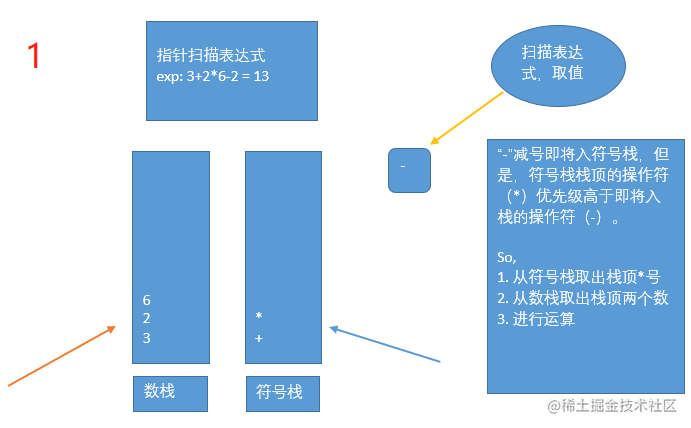package main
import ( "errors" "fmt" "strconv")
type Stack struct { MaxTop int // 栈的容量 Top int // 栈顶下标 默认 -1 arr [20]int // 数组模拟栈}
// 入栈func (stack *Stack) Push(val int) (err error) { // 栈满 if stack.Top == stack.MaxTop-1 { fmt.Println("stack full") return errors.New("stack full") } stack.Top++ // 放入数据 stack.arr[stack.Top] = val return}
// 出栈func (stack *Stack) Pop() (val int, err error) { if stack.Top == -1 { fmt.Println("空栈") return 0, errors.New("空栈") } // 取出数据 val = stack.arr[stack.Top] stack.Top-- return val, nil}
// 遍历栈func (stack *Stack) List() { if stack.Top == -1 { fmt.Println("空栈") return }
for i := stack.Top; i >= 0; i-- { fmt.Printf("arr[%d] = %v \n", i, stack.arr[i]) }
}
// 判断是运算符的函数 + - * / , 利用 ASCII 码func (stack *Stack) IsOper(val int) bool { if val == 42 || val == 43 || val == 45 || val == 47 { return true } else { return false }}
// 运算的方法func (stack *Stack) Cal(num1 int, num2 int, oper int) int { // 注意运算的顺序 res := 0 switch oper { case 42: res = num2 * num1 case 43: res = num2 + num1 case 45: res = num2 - num1 case 47: res = num2 / num1 default: fmt.Println("运算符错误") } return res}
// 返回运算符的优先级: * / => 1 ; + - => 0func (stack *Stack) Priority(oper int) int { res := 0 if oper == 42 || oper == 47 { res = 1 } else if oper == 43 || oper == 45 { res = 0 } return res}
func main() { // 数栈 numStack := &Stack{ MaxTop: 20, Top: -1, }
// 符号栈 operStack := &Stack{ MaxTop: 20, Top: -1, }
// 表达式 exp := "33+2*6/1-2" // 字符串本身也是切片
// 定义需要的变量 num1 := 0 num2 := 0 oper := 0 keepNum := "" // 字符串 用于拼接多位数
// 定义索引,扫描表达式 index := 0 for { ch := exp[index : index+1] // 每次拿到一个字符, 如果数字大于1位就会出问题, 在非符号字符入栈时处理 temp := int([]byte(ch)[0]) // 字符对应的 ASCII 码
if operStack.IsOper(temp) { // 符号 if operStack.Top == -1 { // 1. 符号栈为空 operStack.Push(temp) } else { // 2. 符号栈不为空 // 2.1 栈中的符号优先级大于等于即将入栈的符号 if operStack.Priority(operStack.arr[operStack.Top]) >= operStack.Priority(temp) { num1, _ = numStack.Pop() num2, _ = numStack.Pop() oper, _ = operStack.Pop() result := operStack.Cal(num1, num2, oper) numStack.Push(result) operStack.Push(temp) } else { // 2.2 栈中的符号优先级小于即将入栈的符号 operStack.Push(temp) } } } else { // 数字
// 多位数拼接 keepNum += ch // 判断扫描的下一位是不是运算符, 边界问题(表达式最后, 预防溢出) if index == len(exp)-1 { // 字符 转数字 val, _ := strconv.Atoi(keepNum) // Atoi是ParseInt(s, 10, 0)的简写。 返回的就是 int 类型 numStack.Push(val) } else { // 向后看一位 if operStack.IsOper(int([]byte(exp[index+1 : index+2])[0])) { val, _ := strconv.Atoi(keepNum) // Atoi是ParseInt(s, 10, 0)的简写。 返回的就是 int 类型 numStack.Push(val) keepNum = "" } // 其它情况不做处理,index++, 判断下一个字符 }
/* // 字符 转数字 // val, _ := strconv.ParseInt(ch, 10, 0) // 返回 int64, 需要转 int(val) val, _ := strconv.Atoi(ch) // Atoi是ParseInt(s, 10, 0)的简写。 返回的就是 int 类型 numStack.Push(val) */ }
// 判断扫描位置 if index+1 == len(exp) { fmt.Println("扫描到最后了") break } index++ }
// 扫描完毕,之后对数栈和符号栈剩余元素处理 for { if operStack.Top == -1 { fmt.Println("没有运算符了, 数栈中的值就是计算结果") break } num1, _ = numStack.Pop() num2, _ = numStack.Pop() oper, _ = operStack.Pop() result := operStack.Cal(num1, num2, oper) numStack.Push(result) }
// 如果计算正确,数栈中只剩下一个元素,就是计算结果 res, _ := numStack.Pop() fmt.Printf("表达式: %s = %v \n", exp, res)}












评论